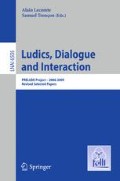Introduction
Semantic Web is the initiative supported by the W3C that aims to make the WorldWideWeb a place of interaction among machines – or at least among their “representatives” known as autonomous agents [3] – thanks to the exchange of “labelled” data. It is clearly something more complex and more interesting than today’s Web, which allows only for the exchange of files and “raw” data that machines simply display on a monitor.
Access this chapter
Tax calculation will be finalised at checkout
Purchases are for personal use only
Preview
Unable to display preview. Download preview PDF.
References
Baader, F., Calvanese, D., McGuinness, D., Nardi, D., Patel-Schneider, P. (eds.): The Description Logics Handbook: Theory, Implementation and Applications. Cambridge University Press, Cambridge (2003)
Berners-Lee, T., Connolly, D., et al: PIM ontology, http://www.w3.org/2000/10/swap/pim/contact
Berners-Lee, T., Hendler, J., Lassila, O.: The Semantic Web, Scientific American (May 2001)
Brickley, D., Miller, L.: The Friend Of A Friend (FOAF) Project, http://www.foaf-project.org/
Girard, J.-Y.: Linear logic. Theoretical Computer Science 50, 1–102 (1987)
Girard, J.-Y.: Locus solum: from the rules of logic to the logic of rules. Mathematical Structures in Computer Science, 301–506 (2001)
Girard, J.-Y., Lafont, Y., Taylor, P.: Proofs and Types. Cambridge University Press, Cambridge (1989)
Gruber, T.: Towards principles for the design of ontologies used for knowledge sharing. Int’l Journal of Human and Computer Studies 43(5-6), 907–928 (1995)
Vander-Wal, T.: Folksonomy (2007), http://vanderwal.net/folksonomy.html
Author information
Authors and Affiliations
Editor information
Editors and Affiliations
Rights and permissions
Copyright information
© 2011 Springer-Verlag Berlin Heidelberg
About this chapter
Cite this chapter
Abrusci, V.M., Romano, M., Fouqueré, C. (2011). Ontologies and Coherence Spaces. In: Lecomte, A., Tronçon, S. (eds) Ludics, Dialogue and Interaction. Lecture Notes in Computer Science(), vol 6505. Springer, Berlin, Heidelberg. https://doi.org/10.1007/978-3-642-19211-1_13
Download citation
DOI: https://doi.org/10.1007/978-3-642-19211-1_13
Publisher Name: Springer, Berlin, Heidelberg
Print ISBN: 978-3-642-19210-4
Online ISBN: 978-3-642-19211-1
eBook Packages: Computer ScienceComputer Science (R0)

